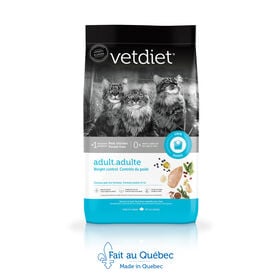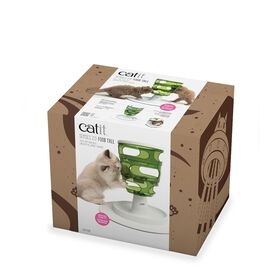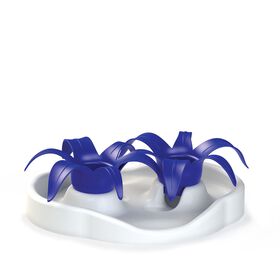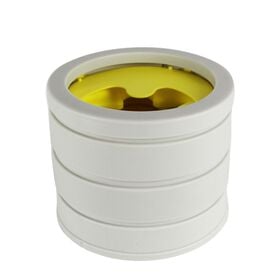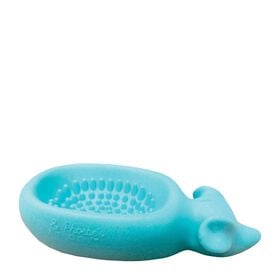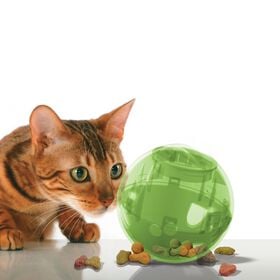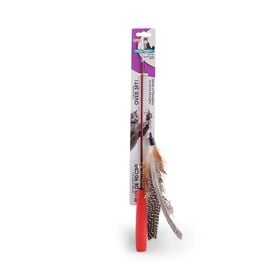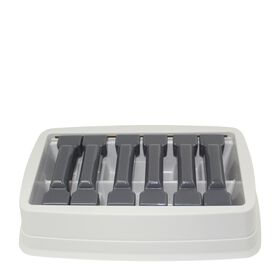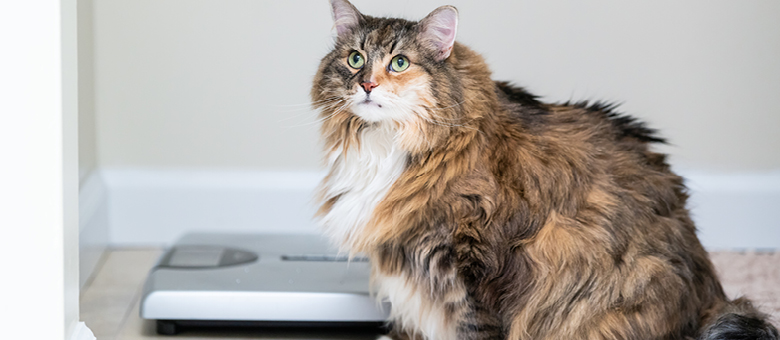
Wouldn’t it be wonderful to be a cat? Nothing to do but eat, sleep and put on weight …
Hey, wait a minute, putting on weight would definitely not be part of that ideal scenario, would it? Yet that’s the reality for many domestic cats. It’s estimated that over 60% of all cats are overweight or, more specifically, are 10% to 20% heavier than they should be. And they’re getting heavier: today’s cats weigh ¼ kg (½ lb) more than those at the end of the last century.1
But ¼ kg doesn’t seem like that much.
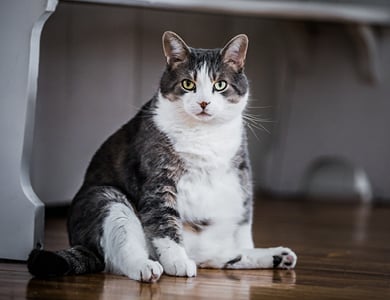
For an average size cat, namely one that weighs 5 kg (11 lb), ½ kg (1 lb) corresponds to nearly 10% of its body weight. In comparison, ½ kg for a cat is equivalent to about 7 kg (15 lb) for a human. In other words, with that extra ½ kg, a cat is already overweight. Since an ounce of prevention is worth a pound of cure, here are a few tips to help keep your cat from gaining weight.
Controlling food intake
The recipe for maintaining healthy body weight is, in theory, quite simple: the amount of energy that your cat takes in, in the form of food, on a daily basis should equal the amount of energy that the cat expends during the day. What complicates the equation is that there are so many factors that affect a cat’s food intake and energy expenditure. Although it may be impossible to control all these factors, it’s relatively easy to control at least some of them.
Start by consulting your veterinarian to verify the portions that your cat should be eating. The amount of food can vary according to the cat’s size and breed. You should generally not rely on what’s written on the bag. Indoor cats often expend a lot less energy than what is used to calculate those portions. Calculating kitty’s daily portions will help prevent excess.
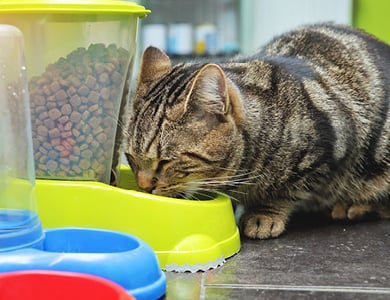
Then, divide up the total amount of food into several small meals given out throughout the day. There are automatic food dispensers that dole out a fraction of a meal at regular intervals. These dispensers are very practical when your schedule doesn’t allow you to feed your cat several times a day, at more or less the same time of day. They are also a good solution to kitty’s early morning feeding schedule that requires breakfast at 5:00 a.m. every morning. A cat that wakes you only because it’s feeding time will quickly learn that the food doesn’t come from you, but from the little machine.
An interactive bowl is vital
Another essential tool for your cat’s meals is an interactive bowl. But what exactly is it? An interactive bowl is anything that requires a cat to work for its food. There’s a wide range of interactive bowls on the market. The only criterion is that the cat has to perform a more or less complicated task to obtain one or several nuggets at a time.
The following are some of the advantages that the bowl provides:
- limits weight gain
- forces the cat to eat more slowly and avoid regurgitating
- prevents or controls several behavioural problems
- satisfies the cat’s need for mental or physical stimulation, and greatly enriches the cat’s environment
Basically, an interactive bowl allows your cat to expend the right kind of energy instead of climbing the curtains, unrolling toilet paper rolls or jumping at your feet as you’re walking by.
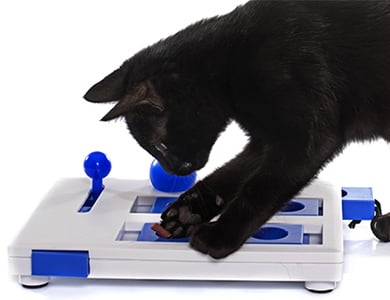
How to use an interactive bowl
From now on, your cat should eat out of an interactive bowl. No more free food. Obviously, in the beginning, some cats will refuse to work for food. After all, they’re cats. The path of least resistance was probably invented by a cat. The bowl has to be extremely easy at first so that the cat finds it enjoyable from the outset. Adding treats or placing food around the bowl may encourage the cat to examine the new object, get used to it and start using it. You can increase the level of difficulty at the cat’s pace until you find the degree of difficulty that allows the cat to enjoy itself (be able to get the food out of its bowl and eat it), while requiring time and effort to do so. A good puzzle should be challenging, but still doable.
A bit of exercise
The last easily controllable factor for maintaining a healthy weight is obviously exercise. Be sure to keep your cat moving every day.
But a cat sleeps all the time, doesn’t it?
Although cats spend a great deal of time snoozing, it’s not normal for them to sleep all the time. Unfortunately, indoor cats have very little reason to move, since they have nothing to do. It is therefore important to enrich a cat’s indoor environment to encourage it to move around on its own. Since cats adopt behaviour only if it is somehow rewarding, moving around the house has to pay off in order for Felix to keep doing it. Using an interactive feeding bowl is already incentive for your cat to move around. Now, why not set up cat trees, shelves or furniture around the house so that kitty has to climb onto them to get what it wants? You can hide toys, cat candy or a mini portion of food on these high-up surfaces to urge your cat to move around. A cat tree in front of a window that looks out onto a bird feeder can suddenly become a wonderfully entertaining observation area. To pique the cat’s curiosity, why not leave a cardboard box, an empty reusable bag or any other potential hiding place lying around? You can even hide one of its toys (or a crumpled up piece of paper) to encourage play.
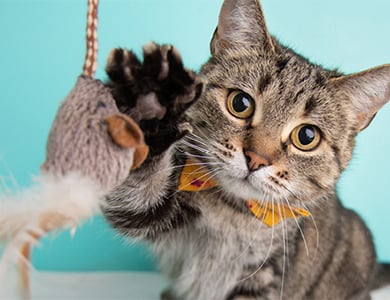
So far, although we’ve focused mainly on autonomous activities, let’s not forget about activities involving the humans in the house! Plan one or two short play sessions with your cat every day so that you develop a good rapport. But, be careful! You can’t play with your cat just any old way! This Educator feature explains how to play with your cat.
What should you do if your cat is already plump?
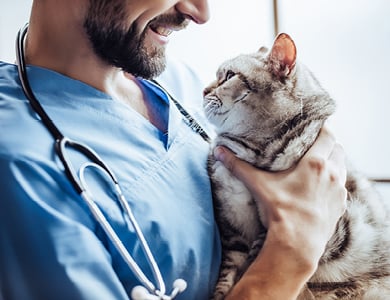
Since obesity is an eating disorder that can lead to other, sometimes serious conditions, it is important to visit your veterinarian. You veterinary team is in the best position to let you know whether you should switch food, what quantities to give and, especially, what type of follow-up is needed to ensure that your cat loses weight. Most veterinary clinics offer weight loss follow-up free of charge, making the process more encouraging. Keep in mind that, like weight gain, rapid weight loss should be avoided. Not feeding your cat enough can lead to as many problems as overfeeding. Your cat’s diet is not something you should take lightly.
The above-mentioned solutions are suitable for all cats, whether or not they are a healthy weight. It’s important to remember that, if you want your cat to move around and use the items that you’ve set up to enrich its environment, there has to be a reward. For some cats, food is the best incentive. If that’s the case, there’s no need to add more food. Use the daily ration of food to encourage your cat to move around. For others (or most cats), starting with easy and rewarding challenges will encourage them to continue and, over time, you can increase the level of difficulty. Ask your Mondou advisor which toys and interactive bowls are most appropriate for your cat.
It’s relatively easy to control your cat’s weight by following these tips. Remember that the health consequences of obesity in cats are very similar to those in humans. You should therefore take this health issue seriously.

